

1. 新疆大学 电气工程学院, 新疆 乌鲁木齐 830046;
2. 清华大学 能源与动力工程系, 北京 100084
收稿日期:2022-01-18
基金项目:国家自然科学基金资助项目(52176011, 52236003);国家重点研发计划项目(2016YFB0901405)。
作者简介:库尔班江·乌丝曼(1985-), 男, 新疆喀什人, 新疆大学讲师, 清华大学博士研究生;
史琳(1964-), 女, 河南洛阳人, 清华大学教授, 博士生导师。
摘要:相变材料(phase change materials, PCMs)是潜热储热技术的核心储热媒介, 因此选择合适的PCMs需综合考虑到多种因素, 而相变温度、储能密度和导热系数是衡量PCMs适用性的最关键因素.对典型的固-液相变的不同类型PCMs特点进行了归纳和比较, 结果证明研究多种高性能兼容的复合材料是PCMs应用的发展方向.通过理论分析得出: 在设定工作温差50 ℃范围内常用PCMs相变潜热≥100 kJ/kg时, 单位质量储热密度与PCMs的相变温度不再相关;PCMs的相变温度越高, 系统的有效输出温度范围越宽, 系统输出越灵活;PCMs的相变潜热越大, 系统在有效温度范围变化时释热效率越稳定.因此在50 ℃工作温差范围内选择相变潜热高、兼顾较高的固液平均比热容和相变温度高的PCMs时系统的输出性能更优越.
关键词:潜热PCMs储热密度相变温度效率
Characteristics of Phase Change Materials and Analysis of Thermal Properties
WUSIMAN Kuerbanjiang1,2, DAI Xiao-ye2, SHI Lin2


1. School of Electrical Engineering, Xinjiang University, Urumqi 830046, China;
2. Department of Energy and Power Engineering, Tsinghua University, Beijing 100084, China
Corresponding author: SHI Lin, E-mail: rnxsl@mail.tsinghua.edu.cn.
Abstract: Phase change materials (PCMs) are the core media of energy storage for latent heat storage. Thus, screening of appropriate PCMs needs to take into consideration a variety of factors, whereas phase transition temperature, energy storage density and thermal conductivity are the most critical factors during assessment of feasibility for PCMs. As evident by summarizing and comparing the characteristics of different categories of typical solid-liquid PCMs, multi-high-performance compatible composite materials is the development direction for PCMs' applications. Finally, based on the theoretical analysis, it concluded as that within the range of specified working temperature difference of 50 ℃, the heat storage density per unit mass of common PCMs is no longer correlated with it's phase transition temperature when latent heat is ≥100 kJ/kg, and the higher of phase transition temperature of PCMs is, the wider range of the effective output temperature can be obtained by the system, and more flexible output of system becomes. The larger the latent heat of PCMs is, the more stable the heat discharging efficiency of the system is while varying the effective temperature. Therefore, within the temperature difference of 50 ℃, the thermal energy storage system gains rather superior output performance with selection of PCMs under considering of it's higher latent heat, competitive average solid-liquid specific heat and higher phase transition temperature.
Key words: latent heatphase change materials (PCMs)heat storage densityphase transition temperatureefficiency
人类在能源利用过程中超过90%的能量是先转化为热能再加以利用, 在中间环节通过热能转换装置将热能直接转化为机械能、化学能、电能等其他能量形式过程中, 由于受到热力学第二定律限制, 大部分热能直接转化效率都低于50%[1], 因此热能转换过程中有大量余热可以收集、储存再利用,提高热效率的潜力.在“双碳”目标推动下, 太阳能光热的广泛利用成为推动可再生能源开发和利用的重要组成部分, 而储热技术不仅成为热能供需匹配的重要解决措施, 也是促进以太阳能为代表的可再生能源的利用更具稳定性和可靠性的有效方法, 更是热能利用过程中节能提效重要手段[2].
1 相变材料的分类和选择储热技术可分为显热储热、潜热储热和化学储热三大类, 其原理示意图如图 1所示[3].显热储热是利用物质的固有比热容进行热量的储存, 在储热过程中伴随着温度的变化;潜热储热主要利用相变材料(PCMs)发生相变时, 吸收或放出大量潜热进行热量的储存, 潜热储热过程中伴随着一部分显热储热过程, 其最大的特点是相变储热过程是等温的过程;化学储热是利用可逆的热化学反应过程对热能与化学能的相互转化从而实现能量的储存.三种储能技术对比如表 1所示[4-5].潜热储热具有比显热储热更高的储能密度(~5倍)及较小温度波动范围[6], 技术突破难度又远低于化学储热, 因此成为当前最受关注的子储热技术.
图 1(Fig. 1)
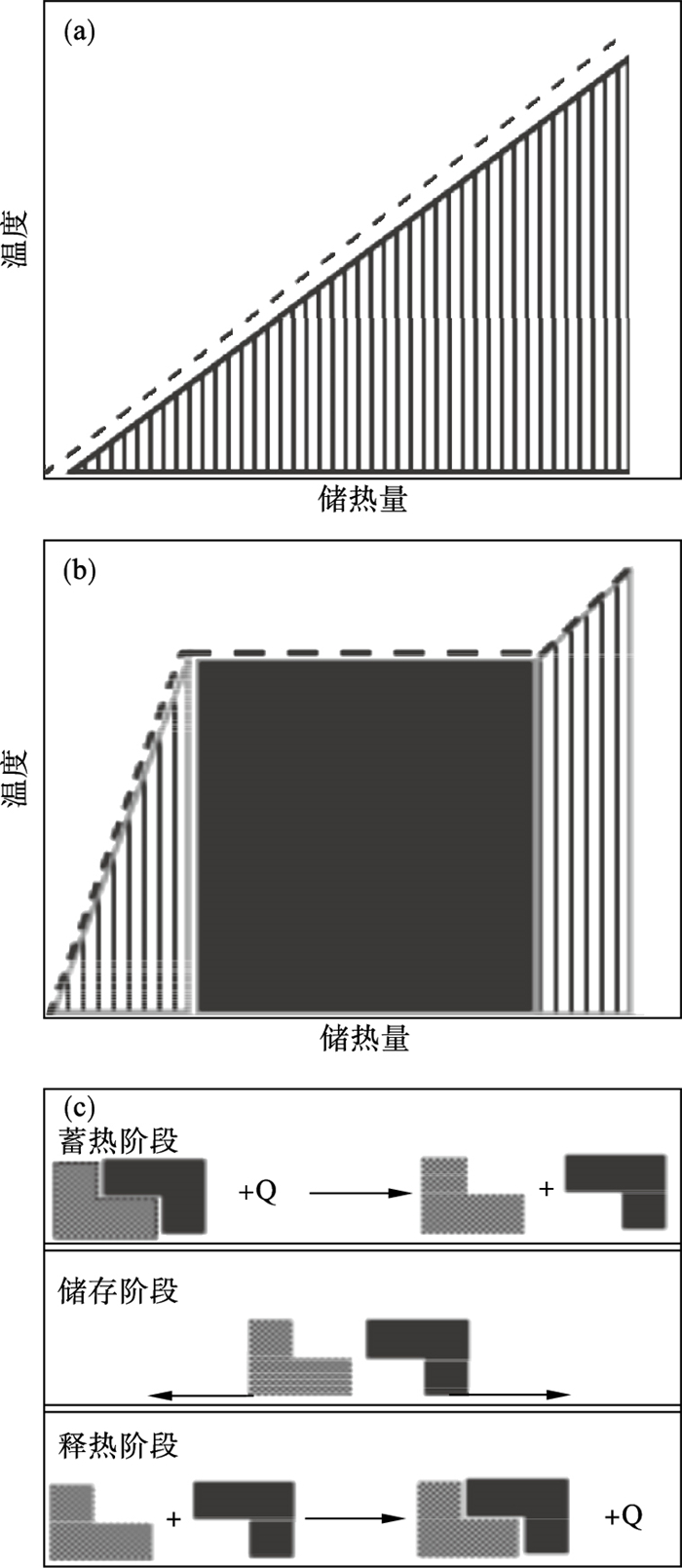 | 图 1 储热原理Fig.1 Principles of heat storage (a)—显热;(b)—潜热;(c)—热化学反应[3]. |
表 1(Table 1)
| 表 1 三种储热技术的对比[1, 4-5] Table 1 Comparison of three heat storage technologies[1, 4-5] |
潜热储热又叫做相变储热, 它是利用PCMs相变过程进行热量的储存和释放.相变储热以PCMs为媒介,其最大特点是相变过程伴有比显热储热更高的热量吸收或释放且为(近似)等温过程, 这正是被众多科研和技术工作者所青睐的原因, 也是相变储热未来具有广阔应用的基础.PCMs按照材料属性又分为有机、无机、共晶混合物及复合材料四大类, 其分类如图 2所示[7-8].
图 2(Fig. 2)
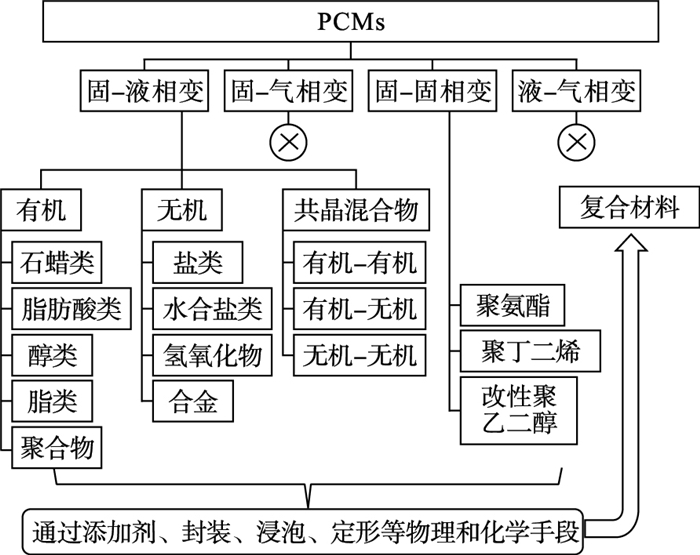 | 图 2 PCMs分类示意图Fig.2 Schematic diagram of PCMs classification |
物质通常有固、液、气三态, 因此PCMs相变形式通常分为固-液、液-气、固-气及固-固相变四种, 因固-气、液-气相变有气体生成导致储存PCMs的容积占比大, 且容积内因密度较大变化导致容器内压力发生较大变化, 在工业应用上带来一定困难及安全隐患, 因此实际应用中固-液相变或固-固相变更受青睐.固-固相变是吸收或释放热量过程中固相不发生变化而固体晶体结构发生变化的过程, 例如Tokoro等研发的储热瓷, 释热过程完全触压可控, 且可以通过输入光能或电流的方式实现固-固相变[9].固-固PCMs比固-液PCMs要少得多[10], 且固-固相变储能材料的开发时间相对较短, 大量的研究工作还有待深入开展, 其应用范围没有固-液相变材料宽广, 因此目前研究应用的绝大多数PCMs属于固-液相变类型.
任何一个潜热储热系统至少包含三个组成部分:在设计温度工况范围内有与之相匹配的相变温度的PCMs, 合适的换热表面及与PCMs相兼容的储存容器[11].而PCMs是相变储热系统的的核心储热媒介, 因此综合衡量其安全性、环保性、实用性和经济性因素之外, PCMs的热物性(相变潜热、密度、导热系数、膨胀系数等)、动力学性质(过冷度、相分离)、化学性质(稳定性、无毒、阻燃性、与材料的兼容性等)是决定储热技术应用的主要因素, 尤其是相变温度(熔化/凝固温度)、储能密度和导热系数是选择PCMs材料的最关键因素[8].
相变温度符合设计所需温度范围是衡量PCMs在应用上的适用性的首要标准, 按相变温度可以把PCMs分为高温(>450 ℃)、中温(100~450 ℃)、低温(0~100 ℃)和超低温(<0 ℃)四类[12], 如石蜡类、水合盐主要运用在低温范围, 大部分有机PCMs主要运用在中低温范围, 而熔融盐、部分金属合金类可用在高温范围.储能密度越高意味着储能系统在储存相同热量时储热器容积越小、结构更紧凑、占地耗材越少[13-14], 经济性也越好, 这就要求PCMs在工作温度范围内有较高的相变潜热和较大的密度, 因此在实际运用中往往更关注100 kWh/m3(冰的相变潜热)以上的PCMs.PCMs导热系数越大, 表明PCMs对热量的吸收和释放响应越快, 输出功率越高.
2 储热材料的特点对实际应用的不同类型PCMs主要特点进行归纳比较如表 2所示.有机PCMs研究最广的是石蜡类、脂肪酸类, 相变温度覆盖范围在超低温及中低温区(-40~151 ℃)[15-16].无机PCMs主要包括水合盐和金属两大类, 金属类又包括低熔点金属和合金类.水合盐类通常是指1 mol无机盐与n mol水结晶成盐的水合物, 即其化学通式为AB·nH2O, 水合盐类固液相变转换是盐脱水和盐水合的循环过程:
表 2(Table 2)
| 表 2 不同类型PCMs主要性能比较[8, 13-14] Table 2 Main performance comparison of different types of PCMs[8, 13-14] |
脱水生成无水盐和水的过程:
 | (1) |
 | (2) |
为了提高传统PCMs导热系数低的固有缺陷, 通过加入高导热材料作为添加剂增强其导热性是复合材料的研究方向之一, 例如金属导热剂微纳米铜粉、铝粉等[20-21], 非金属导热剂碳纳米管、纳米石墨微片、碳纤维等[22-24].而通过与多孔介质结合、微胶囊化、纳米封装等手段削弱PCMs的过冷现象, 强化换热, 增强材料的化学稳定性、兼容性、强度等是复合材料的另一研究方向[25-27].因此通过物理、化学或混合手段得到换热效率高、储能密度高的实用性复合材料是目前PCMs研究的主攻方向[28-29], 例如Liu等利用多孔基体AIN陶瓷的导热性高(>374 W/(m·K))、抗热震性强、化学稳定性好的优点嵌入NaCl/LiNO3 PCMs研制出高导热、高储热密度兼容的相变复合材料[30].
3 PCMs热物性分析3.1 PCMs储热特点分析潜热储热系统以PCMs为储热媒介其储热过程经过固相温度升高、定温相变、液相温度升高三个阶段, 释热过程正好相反, 如图 1b所示, 因此对于相变温度为tm的PCMs在设定工作温度t1, t2之间工作时其理论储热密度qs(kJ/kg)由热力学第一定律公式计算:
 | (3) |
 | (4) |
 | (5) |
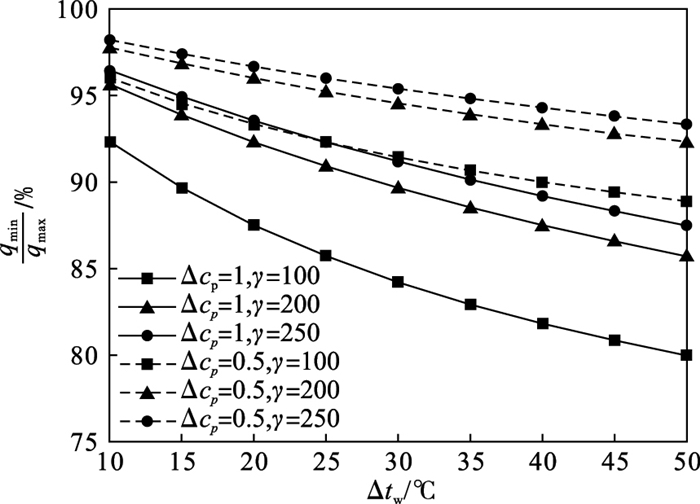 | 图 3 PCMs qmin/qmax随工作温差变化曲线Fig.3 qmin/qmax variation curves with temperature difference of PCMs |
由图 3可知, 当PCMs相变潜热γ≥100 kJ/kg时, 式(5)最大误差在Δtw=50 ℃时≤±10%.随着PCMs相变潜热值γ越高, 固液相比热容差Δcp越小, 误差越小.当γ=250 kJ/kg, Δcp=0.5 kJ/kg/℃时, qmin/qmax≥0.93, 同理由式(5)可得qs的误差值≤±3.5%.
为进一步证实大多数PCMs在Δtw≤50 ℃范围内qmin/qmax差值变化范围, 图 4取固液比热容差值最大(Δcp=1), PCMs相变潜热γ取最小100 kJ/kg时, 绘制PCMs固相比热容在1≤cp≤3.5范围内qmin/qmax随工作温差的变化曲线.由图 4可知, qmin/qmax随PCMs固相比热容cps的增大而缓慢升高, 随工作温差Δtw的增大而降低, PCMs在1≤cp≤3.5范围内qmin/qmax≥0.75, 因此由式(5)可得qs的最大误差在Δtw=50 ℃时≤±12.5%.由此可得系统在工作温差50 ℃范围内对所有适合的PCMs的储热密度qs可由式(5)直接计算, 公式简单, 误差小.对比式(3), 式(5)消除了PCMs的tm在qs的计算影响, 说明在Δtw ≤50 ℃范围内PCMs的单位质量储热密度qs与相变温度tm几乎无关, 与设定的初终温度t1, t2也无关.由式(5)可知PCMs的储热密度qs包括显热cpΔt和潜热γ两部分, 在所有适合的PCMs中优先选择相变潜热γ高的材料, 同时兼顾cp高的材料为宜;尤其是Δtw较大时, 显热储热部分占比突出, 当Δtw=50 ℃, 取多数PCMs的cp≈2 kJ/(kg·K), γ≈100 kJ/kg时, 显热和潜热储热占比相当.
图 4(Fig. 4)
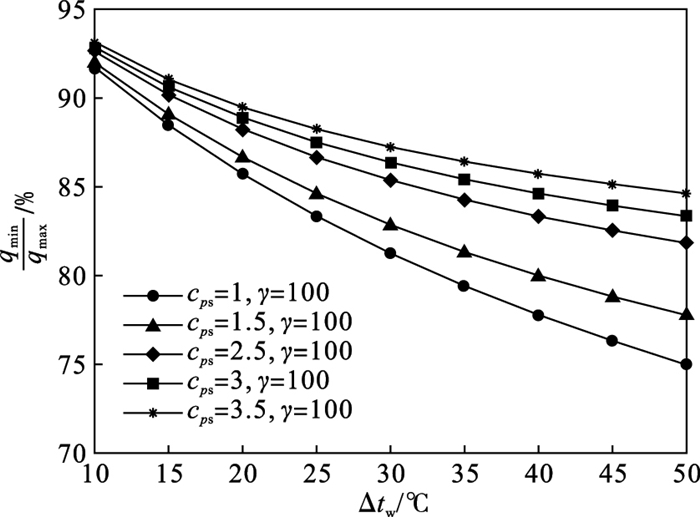 | 图 4 cps在1~3.5 kJ/(kg·K)之间的qmin/qmax随工作温差变化曲线Fig.4 qmin/qmaxvariation curves with temperature difference at cps of between 1~3.5 kJ/(kg·K) |
3.2 相变温度tm的影响储热系统设定的初、终温度t1, t2决定了储热系统通过换热可输出的最低理论温度t1和最高理论输出温度t2, 也确定了适合的PCMs作为储能介质的筛选条件,即所有PCMs的tm均满足:t1≤tm≤t2, 系统在工作温差Δtw≤50 ℃时, 当储热系统输出温度为t时, 其理论释热效率η如下:
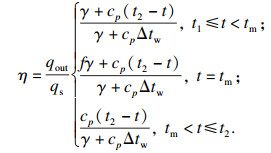 | (6) |
可知, 当系统输出温度t≥tm时, 释热量只有部分显热, 或者部分显热和部分潜热, 释热效率大幅降低, 相变储热系统失效, 不可取.因此tm决定了储热系统的最高有效输出温度, 因此对于qs大致相当的不同PCMs, 尽量选取tm较高的PCMs可提高系统有效输出温度t的范围:即t1≤t≤tm.由式(6)可知, 随着系统有效输出温度的提高, 系统的释热效率会下降, 其最低释热效率ηmin为
 | (7) |
 | (8) |
图 5(Fig. 5)
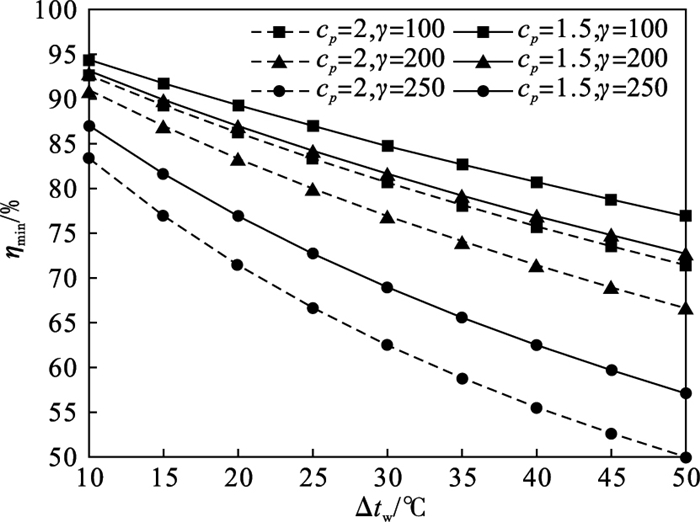 | 图 5 最低释热效率ηmin随工作温差变化曲线Fig.5 Lowest heat release efficiency ηmin curves versus working temperature difference |
图 6(Fig. 6)
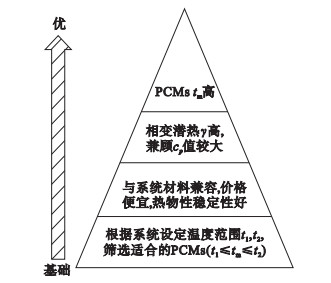 | 图 6 PCMs筛选示意图Fig.6 Schematic diagram for PCMs screening |
4 结论1) 对固-液相变不同类型的传统PCMs特点进行了归纳并做了比较, 阐述了相变温度、储能密度和导热系数三个关键因素对选择PCMs的重要性, 进一步引述了合成性能兼优的复合材料是PCMs应用的发展方向.
2) 通过理论计算分析得出常用的PCMs在设定工作温差Δtw≤50 ℃范围内, 相变潜热γ≥100 kJ/kg时, PCMs的单位质量储热密度qs只与设计工作温差Δtw和相变潜热γ有关, 而与PCMs相变温度tm几乎无关.
3) 单位质量储热密度qs相当的不同PCMs其相变温度tm越高, 有效输出温度范围越宽(t1≤t≤tm), 从而系统温度输出调节越灵活; PCMs的相变潜热γ值越高, 固液相平均比热容cp较小时, 在有效温度范围(t1≤t≤tm)输出时, 系统释热效率变化越缓慢, 因而系统的释热效率越稳定.因此在设定工作温差Δtw≤50 ℃范围内当PCMs单位质量储热密度相当时, 选择相变潜热较高、相变温度较高的材料作为储热介质时系统输出性能更优.
参考文献
| [1] | 李拴魁, 林原, 潘锋. 热能存储及转化技术进展与展望[J]. 储能科学与技术, 2022, 11(5): 1551-1562. (Li Shuan-kui, Lin Yuan, Pan Feng. Research progress in thermal energy storage and conversion technology[J]. Energy Storage Science and Technology, 2022, 11(5): 1551-1562.) |
| [2] | Heier J, Bales C, Martin V. Combining thermal energy storage with buildings: a review[J]. Renewable and Sustainable Energy Reviews, 2015, 42: 1305-1325. DOI:10.1016/j.rser.2014.11.031 |
| [3] | Cabeza, Luisa F, Gracia D, et al. Phase change materials and thermal energy storage for buildings[J]. Energy and Buildings, 2015, 103: 414-419. DOI:10.1016/j.enbuild.2015.06.007 |
| [4] | 汪翔, 陈海生, 徐玉杰, 等. 储热技术研究进展与趋势[J]. 科学通报, 2017, 62(15): 1602-1610. (Wang Xiang, Chen Hai-sheng, Xu Yu-jie, et al. Advances and prospects in thermal energy storage: a critical review[J]. Chinese Science Bulletin, 2017, 62(15): 1602-1610.) |
| [5] | 陈海生, 凌浩恕, 徐玉杰. 能源革命中的物理储能技术[J]. 中国科学院院刊, 2019, 34(4): 450-459. (Chen Hai-sheng, Ling Hao-shu, Xu Yu-jie. Physical energy storage technology in energy revolution[J]. Bulletin of Chinese Academy of Sciences, 2019, 34(4): 450-459.) |
| [6] | Cardenas B, Leon N. High temperature latent heat thermal energy storage: phase change materials, design considerations and performance enhancement techniques[J]. Renewable and Sustainable Energy Reviews, 2013, 27: 724-737. DOI:10.1016/j.rser.2013.07.028 |
| [7] | Khan M M A, Saidur R, Al-Sulaiman F A, et al. A review for phase change materials (PCMs) in solar absorption refrigeration systems[J]. Renewable and Sustainable Energy Reviews, 2017, 76: 105-137. DOI:10.1016/j.rser.2017.03.070 |
| [8] | Nazir H, Batool M, Osorio F, et al. Recent developments in phase change materials for energy storage applications: a review[J]. International Journal of Heat and Mass Transfer, 2019, 129: 491-523. DOI:10.1016/j.ijheatmasstransfer.2018.09.126 |
| [9] | Tokoro H, Yoshikiyo M, Imoto K, et al. External stimulation-controllable heat-storage ceramics[J]. Nature Communications, 2015, 6: 703. |
| [10] | Chandra D, Chellappa R, Chien W M. Thermodynamic assessment of binary solid-state thermal storage materials[J]. Journal of Physics and Chemistry of Solids, 2005, 66: 235-240. DOI:10.1016/j.jpcs.2004.08.047 |
| [11] | Sarbu I, Sebarchievici C A. Comprehensive review of thermal energy storage[J]. Sustainability, 2018, 10(1): 1-32. |
| [12] | 杨才红, 张健, 薛林, 等. 相变材料的研究进展及应用[J]. 节能, 2016, 35(12): 5. (Yang Cai-hong, Zhang Jian, Xue Lin, et al. Research progress and application of phase change materials[J]. Energy Conservation, 2016, 35(12): 5. DOI:10.3969/j.issn.1673-7237.2016.12.002) |
| [13] | Su W, Darkwa J, Kokogiannakis G. Review of solid-liquid phase change materials and their encapsulation technologies[J]. Renewable and Sustainable Energy Reviews, 2015, 48: 373-391. DOI:10.1016/j.rser.2015.04.044 |
| [14] | Cunha J, Eames P. Thermal energy storage for low and medium temperature applications using phase change materials: a review[J]. Applied Energy, 2016, 177: 227-238. |
| [15] | Rubitherm GmbH. Products[EB/OL]. [2021-12-21]. https://www.rubitherm.eu/en/. |
| [16] | PureTemp. Global authority on phase change material[EB/OL]. [2021-12-21]. http://www.puretemp.com. |
| [17] | Lei L A, Bp B, Cy B, et al. Low-cost, shape-stabilized fly ash composite phase change material synthesized by using a facile process for building energy efficiency[J]. Materials Chemistry and Physics, 2019, 222: 87-95. DOI:10.1016/j.matchemphys.2018.09.072 |
| [18] | Ge H S, Li H Y, Mei S F, et al. Low melting point liquid metal as a new class of phase change material: an emerging frontier in energy area[J]. Renewable and Sustainable Energy Reviews, 2013, 21: 331-346. |
| [19] | Khare S, Dell'Amico M, Knight C, et al. Selection of materials for high temperature latent heat energy storage[J]. Solar Energy Materials and Solar Cells, 2012, 107: 20-27. |
| [20] | Zhou W, Zuo J, Ren W. Thermal conductivity and dielectric properties of Al/PVDF composites[J]. Composites Part A: Applied Science and Manufacturing, 2012, 43(4): 658-664. |
| [21] | Mamunya Y P, Davydenko V V, Pissis P, et al. Electrical and thermal conductivity of polymers filled with metal powders[J]. European Polymer Journal, 2002, 38(9): 1887-1897. |
| [22] | Shenogin S, Bodapati A, Xue L, et al. Effect of chemical functionalization on thermal transport of carbon nanotube composites[J]. Applied Physics Letters, 2004, 85(12): 2229-2231. |
| [23] | Yu A, Ramesh P, Itkis M E, et al. Graphite nanoplatelet-epoxy composite thermal interface materials[J]. The Journal of Physical Chemistry C, 2007, 111(21): 7565-7569. |
| [24] | Wang M, Kang Q, Pan N. Thermal conductivity enhancement of carbon fiber composites[J]. Applied Thermal Engineering, 2009, 29(2/3): 418-421. |
| [25] | Delgado M, Lázaro A, Pealosa C, et al. Experimental analysis of the influence of microcapsule mass fraction on the thermal and rheological behavior of a slurry[J]. Applied Thermal Engineering, 2014, 63(1): 11-22. |
| [26] | Alam T E, Dhau J S, Goswami D Y, et al. Macro encapsulation and characterization of phase change materials for latent heat thermal energy storage systems[J]. Applied Energy, 2015, 154: 92-101. |
| [27] | Maier M, Salazar B, Unluer C, et al. Thermal and mechanical performance of a novel 3D printed macro-encapsulation method for phase change materials[J]. Journal of Building Engineering, 2021(9): 103124. |
| [28] | Liu Y, Zheng J, Deng Y, et al. Effect of functional modification of porous medium on phase change behavior and heat storage characteristics of form-stable composite phase change materials: a critical review[J]. Journal of Energy Storage, 2021, 44: 103637. |
| [29] | Zhao Y, Zhang X, Hua W. Review of preparation technologies of organic composite phase change materials in energy storage[J]. Journal of Molecular Liquids, 2021, 336(12): 115923. |
| [30] | Liu X, Wang H, Xu Q, et al. High thermal conductivity and high energy density compatible latent heat thermal energy storage enabled by porous AlN ceramics composites[J]. International Journal of Heat and Mass Transfer, 2021, 175: 121405. |
